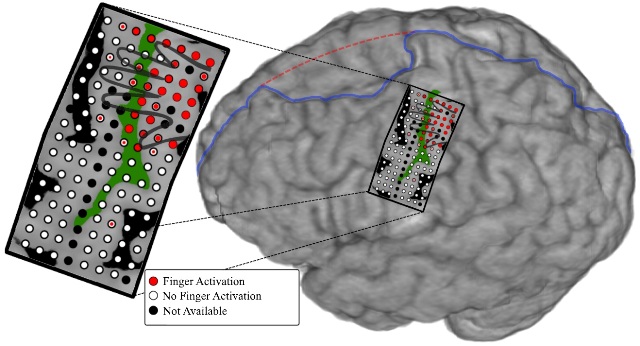Feb 16 2016
Believed to be a first, biomedical engineers and physicians at the John Hopkins Medicine have reported their successful effort to wiggle fingers separately and individually, using a mind-controlled artificial "arm."
 An illustration showing the electrode array on the subject’s brain, including a representation of what part of the brain controls each finger. Credit: Guy Hotson
An illustration showing the electrode array on the subject’s brain, including a representation of what part of the brain controls each finger. Credit: Guy Hotson
Their prototype, reported online in the Journal of Neural Engineering, could signify a potential technological advancement to restore hand functions for people who have lost their forelimbs, either by disease or injury. An experiment was performed on a young man who did not have a missing arm, but he was outfitted with the device that used a brain-mapping procedure to avoid the control from his own arm or hand
We believe this is the first time a person using a mind-controlled prosthesis has immediately performed individual digit movements without extensive training. This technology goes beyond available prostheses, in which the artificial digits, or fingers, moved as a single unit to make a grabbing motion, like one used to grip a tennis ball.
Nathan Crone, M.D., Professor of Neurology, Johns Hopkins University School of Medicine
The young man selected for the experiment was suffering from epilepsy, and was already scheduled for a brain-mapping procedure at the Johns Hopkins Hospital’s Epilepsy Monitoring Unit to identify the source of his seizures.
Electrodes were implanted into the man’s body to provide brain recordings, and the movements of a modular prosthetic limb, produced by the Johns Hopkins University Applied Physics Laboratory, are also controlled by the signals.
Before the prosthetic limb was connected, specific brain parts controlling each finger movement were mapped and tracked. The researchers subsequently programmed the prosthetic limb for moving the matching finger.
A neurosurgeon placed 128 electrode sensors – on a credit card-sized rectangular sheet film – on the part of the brain that controls hand and arm movements. Every individual sensor measured a circle of brain tissue 1 mm in diameter.
The John Hopkins team developed a computer program enabled the young man to move the fingers separately, and it recorded the parts of the brain that “lit up” whenever a sensor sensed an electric signal.
The electrical activity of the brain during tactile sensation was also measured. To achieve this the man was fitted with a glove with vibrational buzzers in the fingertips that went off in each finger. The team measured the the electrical activity for each finger connection in the brain.
After the sensory and motor data collection, the prosthetic arm was programmed to move the corresponding fingers based on the part of the brain that was active. The prosthetic arm, wired to the man by brain electrodes, was turned on and the man was told to “think” about separate movements of his five fingers. The fingers moved based on the electrical activity caused in the brain.
The electrodes used to measure brain activity in this study gave us better resolution of a large region of cortex than anything we’ve used before and allowed for more precise spatial mapping in the brain. This precision is what allowed us to separate the control of individual fingers.
Guy Hotson, Graduate Student
An accuracy of 76% was realized by the mind-controlled limb initially. When the pinkie and ring fingers were coupled, it rose to 88%.
The part of the brain that controls the pinkie and ring fingers overlaps, and most people move the two fingers together. It makes sense that coupling these two fingers improved the accuracy.
Nathan Crone, M.D., Professor of Neurology, Johns Hopkins University School of Medicine
The experiment took less than two hours, and no training was given to the man to realize the level of control.
Mind-Controlled Prosthetic Arm Moves Individual ‘Fingers’
According to Crone, the application of this new technology to those persons with missing limbs is yet to be developed and will be expensive, requiring widespread mapping and computer programming. As per Amputee Coalition, more than 100,000 people in the U.S. have amputated arms or hands, and most people in this group would benefit from the new technology.
Additional authors on the study include David McMullen, Matthew Fifer, William Anderson and Nitish Thakor of Johns Hopkins Medicine and Matthew Johannes, Kapil Katyal, Matthew Para, Robert Armiger and Brock Wester of the Johns Hopkins Applied Physics Laboratory.
The National Institute of Neurological Disorders and Stroke funded the study (grant number 1R01NS088606-01).